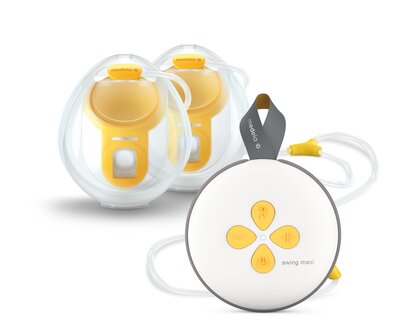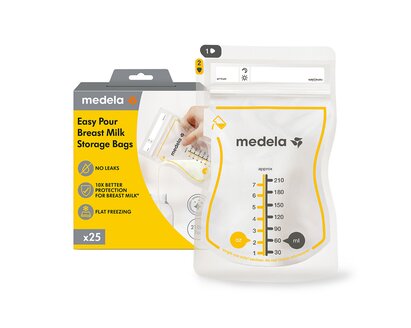For example, if a baby and mum had a difficult birth and the baby was unable to breastfeed well for the first few days and mum was not given enough support to express her milk, then this can lead to low milk supply.
For a few mums, there is a genetic or illness-related reason for low milk supply. For example, women with Poly Cystic Ovarian Syndrome (PCOS) or Diabetes tend to have a delay in their milk volume coming in, in the early days.
Some women may have had a large blood loss after birth, known as a postpartum haemorrhage which can also affect how your milk comes in.
So, it is not always easy to pinpoint the exact reason for low milk supply in every woman. That said, the advice is always the same in how to boost milk supply.
The first thing to understand is that milk supply/volume is based on the principle of “supply and demand”. Or rather what the baby or breast pump “demands (drinks/expresses)” your breasts will “supply!”
So, in theory…
Frequent breastfeeds (expressing if baby is not yet able to breastfeed) = good milk supply
Infrequent breastfeeds or infrequent expressing = low milk supply.
When it Comes to Increasing Your Milk Supply, How Frequent is Enough?
In the first month, babies need to have a minimum number of feeds every 24 hours in order to gain weight and for mum to keep producing enough milk for the next day, and the day after, and the day after that, etc… The minimum number of breastfeeds all babies need is 8 every 24 hours.
When breastfeeding is going well, babies will feed on average anywhere from 8-12 times every 24 hours. This is normal. And actually in the first week or two they may even feed a little more frequently than this. Again this is totally normal.
In the first month, your breasts are building a milk supply for now and the future. What we do to achieve a good milk supply and how much milk we can create in the first month is important for ongoing successful breastfeeding and milk supply.
After the first month, the amount of milk your body has been able to produce per day will be about the volume it continues to produce every day with ongoing breastfeeding or similar expressing. This is known as the maintenance stage of milk supply.
Babies drink about the same amount each day from the end of the first month to six months of age! Yet our babies continue to grow and grow; doubling their birth weight by six months of age!
How Do You Know if Your Milk Supply is Low?
Your health professional will have discussed with you about your baby’s weight loss or how your baby needs to gain more weight. If this is the case your health care provider will have most likely spoken to you about increasing baby’s intake of milk and how to increase your supply.
It is always important to make sure you know for definite that your baby is not gaining enough weight or that you have clear signs of not having enough milk before embarking on efforts to increase your milk supply.
Boosting milk supply can be exhausting and time consuming and should only be done by those mothers who need to. Many mums believe they do not have enough milk supply as their baby feeds frequently.
Frequent breastfeeds do not necessarily indicate a low milk supply. It is very normal for babies to be feeding frequently, if your baby is otherwise gaining weight well, doing lots of wet and dirty nappies and is otherwise healthy and content this is a sign of normal feeding.
Increasing Your Milk Supply While Breastfeeding
Remember Supply and Demand! If your baby has not been meeting 8-12 feeds per day then try offering a breastfeed at times you normally might not and letting baby comfort feed. All those little snacks add up to more milk.
Aim to breastfeed your baby 8 – 12 times every 24 hours, in the first month.
Breast compression and gentle breast massage during feeds can help push more milk into baby’s mouth and help encourage the flow of milk.
If your baby is sleepy during breastfeeds try “switch feeding.” Switch feeding can help those babies who get really sleepy at the breast and for those babies who are not gaining weight well enough.
For example, start a feed on the left breast and feed until baby becomes sleepy or you hear only very minimal swallows. Then “switch” your baby to feed on the right breast.
Once your baby becomes tired on this breast “switch” her back to the other breast. Repeat twice or thrice on each breast, until baby is satisfied.
By feeding this way, it helps to keep your baby alert and utilises the frequent let downs of milk our breasts have throughout feeds.
Try feeding in skin to skin contact as 1) this feels quite lovely for you and baby, 2) it boosts the hormone Oxytocin, which increases the amount of milk your breasts “let down” and 3) helps to improve baby’s attachment to your breast.
If you have sore nipples, it is important to see a midwife, maternal child health nurse or a lactation consultant as soon as you can to help you and baby get comfortable and pain free with breastfeeding.
Incorrect attachment can cause baby to not drink enough milk from the breast, as well as causing you to have sore and damaged nipples.
Increasing Your Milk Supply While Expressing
Express your milk after breastfeeds, either straight away or have a rest for an hour and then express your milk. Do what suits you best, there are no hard and fast rules here.
Discuss with your breastfeeding health care provider (midwife, lactation consultant, or maternal child health nurse) how often you will need to express in addition to breastfeeds.
Everyone is different, and it’s important to not create an over-supply!
Pumping both breasts together (double pumping) has been shown in studies to help express up to 18% more milk, as well as taking half the time of a single pumping session.
Hiring a Symphony breast pump can allow you to use the same breast pump as used in over 80% of hospitals worldwide. This is recommended if you are expressing to increase your milk supply significantly in the first month after birth.
While frequent pumping stimulates milk production, “power pumping” is intended to boost your progress by mimicking the frequent feeding of a baby experiencing a growth spurt, which in turn sends a signal to your body to make more milk.
You may have been advised to top up your baby with extra expressed breast milk after breastfeeds. Your health care provider will give you correct advice about the volumes of expressed breast milk to use and the best feeding methods to give extra milk to your baby.
Ideally, complete your baby’s whole feed (breastfeed and the top up) before you start expressing. This should result in baby getting full up and more likely to settle and sleep allowing you some quiet time to express.
Don’t panic if you see less milk at first! Many women who need to use this type of feeding plan will often commence expressing regularly and soon notice that they are getting less milk out each time they express. This is just because you are fully draining all the milk you are currently making.
Remember “supply and demand” – by expressing in addition to breastfeeding you are asking (“demanding”) your body to make extra milk. It may take 2-3 days for the body to be able to “supply” the extra milk you require.
So, do not worry if you only see small amounts of expressed breast milk at first, remember the expressing you are doing is not wasted, it is sending a message to the breast “demanding” it to make more milk in the future.
Other Tips That May Help Boost Milk Supply
Rest, rest, rest as much as you can! Limit all visitors and get as much support as possible.
This feeding and expressing plan is really hard work. Do not try to fit in anything else in your day!
Remember, this feeding plan is only temporary. It’s just until you have boosted your milk supply and your baby’s milk intake. You should hopefully start to notice more milk over the next 3-4 days.
Enhance the Oxytocin hormone. Yes, it was mentioned above, but this is a really powerful hormone when it comes to breastfeeding and breast milk! Boosting your Oxytocin hormone by holding your baby, lying with your baby, and generally gazing at your baby and feeling the love increase it really important. This is meant to feel relaxing and wonderful.
Enjoy it. Use skin to skin contact as a perfect excuse to spend time cuddling your baby, or playing tummy time with baby on your chest, whilst you also get to relax and unwind at the same time. Oxytocin release is great for mum, bub and your breast milk!
Talk to your General Practitioner about Galactagogues. This is a fancy word for medicines which may boost your milk supply.
Talk to your General Practitioner about whether a galactagogue medicine is right for you. You may have also been recommended to take herbs. The best advice is to speak to a qualified herbalist or naturopath to ensure you are using herbs which are safe for you and your bub.
Avoid soothers. Your baby needs to be suckling at your breast as frequently as possible to stimulate a good milk supply.
So, as you can see, boosting your milk supply is all down to “supply and demand”. To increase milk supply we need to increase the “demand” for it. Sometimes that needs to involve using the pump to express extra milk as well as ensuring our baby is feeding enough times throughout a normal day.
Do you have any breastfeeding questions that we can answer? Please join the conversation here or on our Medela Australia Facebook page.






















































